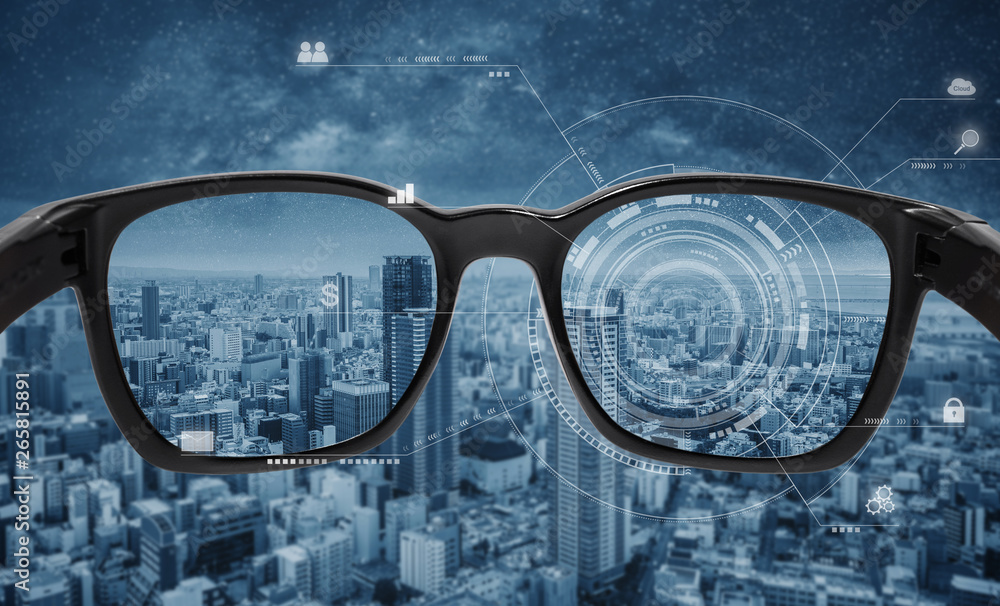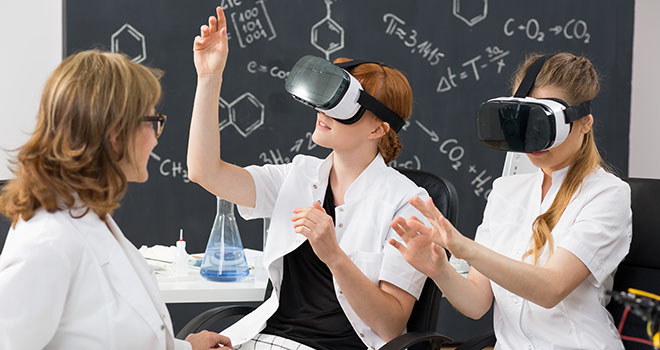
Augmented Reality (AR) and Virtual Reality (VR) have emerged as transformative technologies, reshaping how we interact with digital content and the physical world. These technologies are becoming increasingly accessible, driven by advancements in hardware and software. Smart glasses are one of the critical hardware components enabling AR and VR experiences. In this comprehensive blog, we will explore the fundamental differences between AR and VR, the role of smart glasses in both, and their applications, benefits, challenges, and prospects.
Understanding Augmented Reality (AR)
What is Augmented Reality?
Augmented Reality (AR) is a technology that overlays digital information—images, videos, and sounds—onto the real world. Unlike Virtual Reality, which immerses users in a wholly digital environment, AR enhances the real-world environment with virtual elements.
How AR Works
AR technology typically involves the following components:
- Cameras and Sensors: Capture the user’s surroundings and track movements.
- Processing Unit: Analyzes the captured data and integrates digital content into the real world.
- Display: Projects the augmented content onto the user’s field of view.
Applications of AR
AR has a wide range of applications across various industries, including:
- Retail: Enhancing the shopping experience by allowing customers to visualize products in their own space before purchasing.
- Education: Providing interactive learning experiences through 3D models and simulations.
- Healthcare: Assisting surgeons with real-time information during procedures and aiding in medical training.
- Gaming: Creating immersive and interactive gaming experiences in the real world.
- Manufacturing: Offering visual guidance for assembly and maintenance tasks.
Understanding Virtual Reality (VR)
What is Virtual Reality?
Virtual Reality (VR) is a technology that creates an entirely immersive digital environment, shutting out the physical world. Users interact with this environment through VR headsets and controllers, experiencing a sense of presence in the virtual space.
How VR Works
VR technology involves the following components:
- Head-Mounted Display (HMD): Encloses the user’s vision and displays the virtual environment.
- Motion Tracking Sensors: Track the user’s head and body movements to adjust the virtual environment accordingly.
- Input Devices: Controllers or gloves that allow users to interact with the virtual environment.
Applications of VR
VR has a broad range of applications, including:
- Entertainment: Providing immersive gaming and virtual reality experiences in movies.
- Training and Simulation: Offering realistic training environments for pilots, soldiers, and medical professionals.
- Education: Enabling immersive learning experiences through virtual field trips and interactive lessons.
- Therapy: Assisting in treating phobias, PTSD, and other mental health conditions.
- Real Estate: Allowing potential buyers to take virtual tours of properties.
The Role of Smart Glasses in AR and VR
Smart Glasses for AR
Overview
Smart glasses designed for AR overlay digital information onto the user’s field of view, enhancing their interaction with the real world. These glasses are equipped with transparent displays, cameras, and sensors to achieve seamless integration of virtual content.
Key Features
- Transparent Displays: Allow users to see the natural world and the digital overlay.
- Cameras and Sensors: Capture the environment and track the user’s movements.
- Lightweight and Wearable: Designed for comfort and extended use.
Popular AR Smart Glasses
- Microsoft HoloLens offers advanced spatial mapping and interaction capabilities and is widely used in enterprise applications.
- Google Glass: Focuses on providing hands-free access to information and notifications, primarily used in professional settings.
- Magic Leap One: Known for its high-quality graphics and spatial computing capabilities.
Applications
- Healthcare: Assisting surgeons with real-time information and visual aids during surgeries.
- Retail: Enhancing the shopping experience with virtual try-ons and product visualizations.
- Field Service: Providing technicians with visual instructions and remote support.
Smart Glasses for VR
Overview
Smart glasses designed for VR create a fully immersive digital environment, blocking the real world. These glasses typically require more sophisticated hardware to accurately render high-quality graphics and track movements.
Key Features
- High-Resolution Displays: Provide a lifelike and immersive visual experience.
- Motion Tracking Sensors: Track the user’s head and body movements to adjust the virtual environment.
- Comfortable Design: Ensures users can wear the glasses for extended periods without discomfort.
Popular VR Smart Glasses
- Oculus Quest 2: Offers a standalone VR experience with high-quality graphics and a wide range of applications.
- HTC Vive: Known for its precise motion tracking and immersive experiences, it is widely used in gaming and professional training.
- Sony PlayStation VR: Provides an accessible VR experience integrated with the PlayStation gaming console.
Applications
- Gaming: Creating immersive and interactive gaming environments.
- Training and Simulation: Providing realistic training environments for various professions.
- Virtual Travel: Allowing users to explore virtual recreations of real-world locations.
Comparing AR and VR: Key Differences
Immersion Level
- AR: Enhances the real world by overlaying digital content, allowing users to remain aware of their surroundings.
- VR: Creates an entirely immersive digital environment, blocking out the real world.
Interaction
- AR: Users interact with both the natural world and digital content simultaneously.
- VR: Users interact exclusively with the digital environment.
Hardware Requirements
- AR: Requires transparent displays and sensors for real-world integration.
- VR: Requires high-resolution displays and precise motion tracking for immersion.
Applications
- AR: Widely used in industries like retail, healthcare, and manufacturing.
- VR: Used mainly in gaming, training, and entertainment.
Benefits of AR and VR Smart Glasses
AR Smart Glasses
· Enhanced Productivity
AR smart glasses can provide real-time information and instructions, enhancing productivity in various professional settings. For example, field service technicians can access repair manuals and remote assistance while keeping their hands free.
· Improved Learning and Training
AR smart glasses offer interactive and engaging learning experiences. Medical students can visualize complex anatomical structures, and industrial workers can receive step-by-step assembly instructions.
· Better Customer Experiences
AR smart glasses can enhance customer experiences in retail by allowing virtual try-ons and product visualizations. This technology helps customers make informed purchasing decisions and reduces return rates.
VR Smart Glasses
- Immersive Experiences
VR smart glasses provide fully immersive experiences, making them ideal for gaming, entertainment, and virtual travel. Users can explore virtual worlds and engage with digital content in a lifelike manner.
- Realistic Training Simulations
VR smart glasses offer realistic training simulations for various professions, including pilots, soldiers, and medical professionals. These simulations provide a safe environment for practising skills and improving performance.
- Therapeutic Applications
VR smart glasses have therapeutic applications in treating mental health conditions. For example, exposure therapy for phobias and PTSD can be conducted in a controlled virtual environment.
Challenges and Limitations
AR Smart Glasses
- Technical Limitations
AR smart glasses face technical challenges, such as limited field of view, low battery life, and the need for precise spatial mapping. These limitations can affect the user experience and the effectiveness of AR applications.
- Privacy Concerns
AR smart glasses can raise privacy concerns, often including cameras and sensors that capture the user’s surroundings. Ensuring data security and addressing privacy issues are critical for widespread adoption.
- User Acceptance
The design and form factor of AR smart glasses can impact user acceptance. Bulky or uncomfortable designs may deter users from adopting the technology, especially for extended use.
VR Smart Glasses
· Motion Sickness
One of the common challenges with VR smart glasses is motion sickness, caused by a mismatch between visual and physical movement. Reducing motion sickness is essential for improving user comfort and adoption.
· High Cost
High-quality VR smart glasses can be expensive, limiting their accessibility to a broader audience. Reducing costs without compromising quality is crucial for widespread adoption.
· Limited Mobility
VR smart glasses typically require a stationary setup, limiting user mobility. This can restrict VR use in scenarios requiring movement and physical interaction.
Future Prospects of AR and VR Smart Glasses
- Advancements in Technology
Technology advancements are expected to address many of the current challenges faced by AR and VR smart glasses. Improvements in display technology, battery life, and motion tracking will enhance the user experience and expand the potential applications.
- Integration with 5G
The integration of 5G technology will enable faster data transmission and lower latency, enhancing the performance of AR and VR applications. This will allow for more seamless and responsive experiences, particularly in remote assistance and real-time collaboration.
- Expanded Applications
As AR and VR technologies evolve, their applications will continue to expand across various industries. AR smart glasses will find new use cases in tourism, real estate, and social media. VR smart glasses will see increased adoption in fields like remote work, virtual events, and collaborative design.
- Increased Accessibility
Efforts to reduce costs and improve the design of AR and VR smart glasses will make these technologies more accessible to a broader audience. This will drive greater adoption and integration into everyday life, transforming how we interact with digital content and the physical world.
Augmented Reality and Virtual Reality represent two distinct but complementary technologies that can potentially transform various aspects of our lives. Smart glasses are crucial in enabling AR and VR experiences, offering unique benefits and challenges.
AR smart glasses enhance our interaction with the natural world by overlaying digital content, improving productivity, learning, and customer experiences. VR smart glasses provide fully immersive experiences ideal for gaming, training, and therapeutic applications.
Despite the challenges, the future of AR and VR smart glasses is promising, with ongoing technological advancements, integration with 5G, and expanding applications. As these technologies evolve, they will redefine how we interact with digital content and the physical world, offering new possibilities and opportunities for innovation.
In the coming years, we can expect AR and VR smart glasses to become more integrated into our daily lives, enhancing our experiences and transforming industries. By addressing current limitations and leveraging technological advancements, AR and VR will continue to push the boundaries of what is possible, shaping the future of human-computer interaction.



